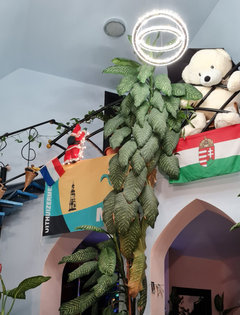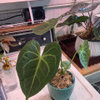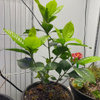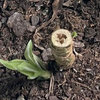Highest Dieffenbachia
Theo van der Burg
last year
last modified: last year
Featured Answer
Sort by:Oldest
Comments (10)
floral_uk z.8/9 SW UK
last yearTheo van der Burg
last yearRelated Discussions
"Mystery poison ivy," contact dermatitis rash from house plants
Comments (43)I too am EXTREMELY SENSITIVE to poison ivy and recently broke out in a similar rash after being careless while propagating my all time favorite plant, the philodendron micans. I also suspected that had to be it so I took a fresh cutting and dabbed the sap several times in my arm and didn't wash off for a few hours. Somewhere between 12 & 24 hours later, I started feeling that familiar itch and watched as my test patch gradually spread out the size of a dime and rose up with the little tiny bubble pattern I'm used to seeing with poison ivy rash. THIS SUCKS! I'm in the middle of battling it right now and in my research found this helpful article. I also read another helpful tip that said the sap from these plants can somehow penetrate through standard medical gloves so thicker gardening type gloves should be used when propagating and caution should also be taken when refreshing propagation water. I plant to purchase some thick, SOLID rubber gloves that can easily be thoroughly washed. NOT those gardening gloves that have a breathable section at the back of the hand and wrists! You should also clean the tools you use and the work area. Rubbing alcohol AT LEAST 70% grade is known to be effective for cleaning tools that have come in contact with poison ivy so I plan on implementing that. As well as never shortcutting again by taking rushed cuttings and not doing the basics like laying out a protective mat and immediately washing my hands afterwards. I lazily let my NUMEROUS cuttings drop to the floor (CARPET!) and I know I didn't wash my hands right away like I normally do. A couple hours later I laid on this floor in a tank top and got a mild rash a day later across my upper back and shoulder area as well as my ear lobes which I believe is from handling my earbuds right after propagating my favorite plant. PLEASE MAKE MY PAIN WORTH IT AND LET THIS BE A LESSON TO YOU... PUH-LEAZE!...See MoreBrittle Dieffenbachia
Comments (9)It may be a combination of the 2. Too cool and too bright. Good point about the light. At this time of year, the sun's angle shifts and reaches into a room to a greater extent than during summer months in northern zones. In another month the current placement may be more appropriate. [November to early February] In late February, take care. The sun will begin to intensify. If the plant was purchased through a Big Box store it may need slow acclimation to better light and your conditions. Some loss may be inevitable. When I bought plants in big box stores I noticed it took a longer time to acclimate them. No way of knowing how long they have been there. Some plants need 30-50 days to settle in. I went 10 rounds with a Fittonia this summer, similar problem. Big Box suppliers will grow plants purposely under-acclimated for 'ornamental & toss' home use. Not everyone is a plant person. Many are grown in the lowest light conditions, highest temperature spectrum during the production phase. [Highest yield] Some Green House retailers grow similarly or receive their plants from the same source as a Big Box. Meg...See Morerecent Consulting Rosarian rose prunning article
Comments (25)"biocontrol" is one method that one can try for blackspot. The following may be useful in putting the concept of biocontrol into layman terms: "Disease-suppressive soil microorganisms have been found in many places. In monoculture wheat the severity of "take all" disease often decreases within three to five years. This phenomenon is known as "take all decline," and is considered an effective natural control. Although the mechanisms are not completely understood, the decline is associated with changes in soil microorganisms that compete with and prey on the fungus. Melon plants grown in the Chateaurenard region of France do not show Fusarium wilt symptoms even though the fungus is present in the soil. Soils with suppressive characteristics tend to develop slowly and are usually found in fields where perennial crops or monocultures have been grown for many years. Suppressiveness may be lost if the monoculture is interrupted even for one year, or if pesticides are applied. For example, researchers first recognized soils suppressive to cereal-cyst nematode when nematode numbers increased after application of a broad-spectrum biocide. Many species of fungi and bacteria in the genera Trichoderma, Streptomyces, Bacillus and Pseudomonas suppress diseases, but at this time only a few strains are commercially available. Additional commercial products may be available soon, however, as this is currently an active research area." The quote was taken from: Http://www.cals.ncsu.edu/sustainable/peet/IPM/diseases/org_cert.html ---------------------------------------------- The following article from the Maine Rose Society web page ( http://www.mainerosesociety.com/articles/control.html ) was written by by DR. LAKSHMI SRIDHARAN, who should be familar with those of you that are members of the American Rose Society. ----------------------------------- Examples that friendly fungi do exist: Http://taylorandfrancis.metapress.com/app/home/contribution.asp?wasp=59ghxnlylp03feg2dr2p&referrer=parent&backto=issue,1,10;journal,2,54;linkingpublicationresults,1:100635,1 Http://taylorandfrancis.metapress.com/app/home/contribution.asp?wasp=4g1ltlxhtr3ya223recn&referrer=parent&backto=issue,8,10;journal,4,54;linkingpublicationresults,1:100635,1; Http://taylorandfrancis.metapress.com/app/home/contribution.asp?wasp=8000375kwm5qnk5e7y47&referrer=parent&backto=issue,1,10;journal,6,54;linkingpublicationresults,1:100635,1; Http://taylorandfrancis.metapress.com/app/home/contribution.asp?wasp=07wckmqrxr3jqg6kducy&referrer=parent&backto=issue,9,10;journal,7,54;linkingpublicationresults,1:100635,1; ------------------------------------------------ Blackspot on roses is scientifically called "diplocarpon rosae". The link below reports that trichoderma harzianum is a promising control - see their exact wording (the document is a PDF document. The applicable section is easily found by typing diplocarpon into the PDF find command - the binoculars). Http://www.gtz.de/ecosan/download/Bangalore03-Ramanujam.PDF ------------------------------------------------------ Title: The Abundance and Structure of the Root-Associated Microbial Complexes of Two Greenhouse Rose Cultivars. Authors: Polyanskaya, L. M.; Ozerskaya, S. M.; Kochkina, G. A.; Ivanushkina, N. E.; Golovchenko, A. V.; Zvyagintsev, D. G. Authors affiliation: Faculty of Soil Science, Moscow State University, Vorob'evy gory, Moscow, Russia. Published in: Microbiology (Moscow, Russian Federation)(Translation of Mikrobiologiya), volumn 72, pages 496-502, (2003). Abstract: "The study of the root-assocd. microbial complexes of affected and healthy rose plants of two cultivars (Grand gala and Royal velvet) grown in a greenhouse showed that the biomass of eukaryotic microorganisms in the rhizoplane and rhizosphere of healthy rose plants and in the surrounding soil was considerably lower than in the same loci of affected plants. In contrast, the biomass of root-assocd. prokaryotic microorganisms was higher in the case of healthy than in the case of affected rose plants. The root-assocd. bacterial complexes of both affected and healthy rose plants were dominated by the genera Arthrobacter, Rhodococcus, and Myxobacterium and did not contain phytopathogenic bacteria. The root-assocd. fungal complex of healthy roses was dominated by fungi of the genus Trichoderma, whereas that of the affected rose plants was dominated by the species Aureobasidium microstictum. The affected cane cuttings and cankers occurring on affected canes were found to contain Coniothyrium fu-ckelii (the causal fungus of rose stem canker) and sclerotia of Botrytis cinerea (the causal fungus of gray rot). The micromycete complex of healthy rose plants was not so diverse as was the micromycete complex of affected rose plants." ---------------------------------------------- Title: Biological control of black spot of rose caused by Dipocarpon rosae . Authors: Prasad, R. D.; Rangeshwaran, R.; Sunanda, C. R.; Vinita, J. Authors affiliation: Project Directorate of Biological Control, Post Bag No. 2491, H.A. Farm Post, Bellary Road, Hebbal, Bangalore 560 024, India. Published in: Annals of Plant Protection Sciences,volumn 10, pages 256-259, (2002). Abstract: "Fungal biological control agents (Trichoderma harzianum , T. viride and Chaetomium globosum ) were used either alone or in combination with fungicides (chlorothalonil and mancozeb) to manage black spot of rose caused by D. rosae under greenhouse conditions. Black spot incidence in biological control agent and/or fungicide treatments was significantly low (disease ratings from 0.33 to 3.33) compared to the control at all observation dates. After 100 days of spraying, defoliation was lowest with chiorothalonil, Trichoderma harzianum +chlorothalonil, C. globosum +chlorothalonil and T. harzianum +mancozeb treatments. The highest mean vigour index was recorded in T. harzianum treatment. The highest flower production was recorded in C. globosum +chlorothalonil treatment (4.33) followed by T. harzianum alone and T. harzianum +chlorothalonil treatment (4.00)." -------------------------------------------------- Cornmeal is considered to be a good food for the friendly fungus "trichoderma harzianum". The fungus is available commercially, see: http://www.ipmofalaska.com/files/trichoderma.html There may be another benefit to this fungus as there is a report that it helps root growth: Title: Effect of Trichoderma Colonization on Auxin-Mediated Regulation of Root Elongation. Author: Bjoerkman, Thomas. Department of Horticultural Sciences, Cornell University, Geneva, NY, USA. Published in: Plant Growth Regulation, volumn 43, pages 89-92, (2004). Abstract: "The biocontrol fungus Trichoderma harzianum 1295-22 increases root growth in addn. to roles in suppressing disease. Its agricultural use could be expanded if the mechanism of growth enhancement were known. Among the proposed mechanisms of growth enhancement is that the fungus counteracts auxin inhibition of root-cell elongation. We tested whether there was evidence for a secreted auxin inhibitor, for enhanced auxin degrdn., or for altered auxin sensitivity. Our results provide no support for any of these mechanisms. Trichoderma secretions inhibited growth, whereas an auxin inhibitor would increase growth. Auxin inhibited growth to the same extent in colonized and uncolonized roots, indicating no change in auxin sensitivity. Endogenous auxin levels maintained growth closer to the max. in uncolonized roots, indicating stronger auxin limitation of growth in colonized roots. These tests indicated that Trichoderma-colonized roots had a faster max. growth rate, but an unchanged response to auxin." -------------------------------------------- Even if naturally occurring trichoderma harzianum only reduces the amount of blackspot fungus by 10 to 20 % (the numbers are just a guess), there are probably going to be a number of different "friendly" fungi in an organic garden. For example, the following paper reports that 2 fungi that are now recognized as biocontrol potential have increased levels on blackspot infected leaves: ------------------------------------ Title: PHYLLOPLANE MICROORGANISMS OF ROSA CULTIVAR PICADILLY FOLLOWING INFECTION BY DIPLOCARPON-ROSAE Author: HAYES A J Author Affiliation: DEP OF FORESTRY AND NATURAL RESOURCES, UNIV OF EDINBURGH, UK. Published in: Transactions of the British Mycological Society, volumn 79, pages 311-320, (1982). Abstract: "The phylloplane microflora of the hybrid tea rose cultivar Picadilly was studied for 2 growing seasons on healthy leaves and on leaves infected by D. rosae. Large increases in numbers of yeasts and bacteria on healthy leaves were noted from the end of July until the beginning of Oct. Late in the growing season numbers of all types of microbes increased dramatically. Following infection by D. rosae numbers of microbes generally showed a marked increase, but this was not always sustained. Cryptococcus laurentii and Micrococcus sp. populations on infected leaves were 3-4 times those on correspondingly healthy leaves. The species composition and changes in numbers of phylloplane microbes are compared with descriptions of microflora isolated from leaves of other plants and possible reasons for the observed differences are discussed." -------------------------------------- The following two links are Google searches for the two fungi listed and the word biocontrol. --------------------------------------- Http://www.google.com/search?hl=en&lr=&q=%22cryptococcus+laurentii%22+biocontrol&btnG=Search ----------------------------------------------- Http://www.google.com/search?hl=en&lr=&q=micrococcus+biocontrol&btnG=Search ------------------------------------------- The science of biocontrol is still in its infancy. The use of Chitosan is one of the early results of this area of research. The following is the EPA summary: ( Http://www.epa.gov/pesticides/biopesticides/ingredients/factsheets/factsheet_128930.htm ) "SUMMARY Chitosan is used primarily as a plant growth enhancer, and as a substance that boosts the ability of plants to defend against fungal infections. It is approved for use outdoors and indoors on many plants grown commercially and by consumers. The active ingredient is found in the shells of crustaceans, such as lobsters, crabs, and shrimp, and in certain other organisms. Given its low potential for toxicity and its abundance in the natural environment, chitosan is not expected to harm people, pets, wildlife, or the environment when used according to label directions." -------------------------------------------- There is a scientific literature report of 10 - 20 % effectiveness against blackspot. Title: Chitosan as the biocontrol agent of fungal pathogens; activity and mode of action. Authors: Wojdyla, Adam T. Authors affiliation: Research Institute of Pomology and Floriculture, Skierniewice, Pol. Published in: Bulletin of the Polish Academy of Sciences: Biological Sciences, volumn 51, pages 159-165, (2003). Abstract: "In in vivo expts. showed that chitosan added to potato dextrose agar at 3 mg/cm3 in 50% suppressed radial growth of Colletotrichum gloeosporioides and Phytophthora cryptogea. Another tested fungi were less sensitive to chitosan. ED50 for Cylindrocladium scoparium and Myrothecium roridum was more than 5 mg/cm3. In vivo expts. showed that only 10-20% effectiveness of the compds. against Diplocarpon rosae was found, when chitosan at 0.2-0.4 mg/cm3 was used for rose spraying. Also spraying of willow 2 times at weekly intervals against Melampsora epitea decreased the mean no. of rust pustules per leaf. Spraying of dieffenbachia 24 h before inoculation with M. roridum resulted in significant decrease of necrosis spread on leaves. Five days after inoculation the compds. inhibited the development of leaf spot about 94%. Chitosan applied preventively before inoculation of leaves gave significantly better results in the control of M. roridum than used 24 h after inoculation. Spraying of chrysanthemum, naturally infected with Puccinia horiana decreased the mean no. of pustules per leaf about 95%."...See MoreSuggestions
Comments (6)If it is not a light or water issue, besides what's in the fertilizer, different plants prefer different fertilizer strengths. It is like comparing what to put in the plate if you get Joey Chestnut vs. Kate Moss over for dinner, if you swap their diets they might die, at least from the stress of not swallowing at their own speed;-) Concentrated nutrients force feed plants due to nutrient pressure and this can cause problems unless you are dealing with a tote filled with Audrey II There is probably a lot of info you can browse around on line for to compare the strength if you don't have another way of estimating it. It might give you a higher batting average. Does your fertilizer contain micronutrients? Check that, since that's another reason some plants might not grow in your water + fertilizer. This post was edited by PupillaCharites on Thu, Sep 19, 13 at 16:41...See MoreTiffany, purpleinopp Z8b Opp, AL
last yearTiffany, purpleinopp Z8b Opp, AL
last yearTheo van der Burg
last yeartropicbreezent
last yearTheo van der Burg
last yearTiffany, purpleinopp Z8b Opp, AL
last yearTiffany, purpleinopp Z8b Opp, AL
last year
Sponsored
Columbus Design-Build, Kitchen & Bath Remodeling, Historic Renovations










Theo van der BurgOriginal Author